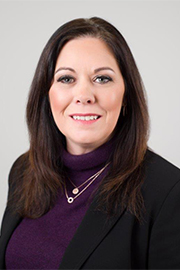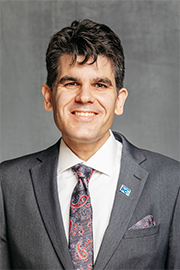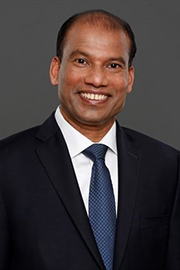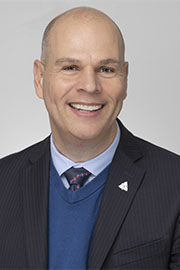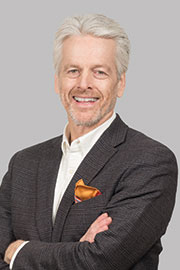- Sep/27/23 10:30:00 a.m.
It’s my honour to introduce some visitors from Windsor and Essex county.
We have Mike Kessler, a client of the Alzheimer Society of Windsor and Essex County, as well as an incredible advocate for people living with dementia, and his caretaker, Karen Kessler.
I would also like to introduce the CEO of the Alzheimer Society of Windsor and Essex County, Sally Bennett Olczak.
I also have other guests I would like to introduce. It’s my incredible honour to welcome directly into Queen’s Park the chief of Caldwell First Nation, Chief Mary Duckworth; Larry Sault; Councillor Ian Duckworth; and Councillor Doug Heil.
Welcome to your House.
- Hear!
- Rabble!
- Sep/27/23 4:40:00 p.m.
- Re: Bill 131
You know, it’s interesting: an act called the Transportation for the Future Act is right up my alley as a civil engineer. Even though Metrolinx and GO Transit really don’t touch upon my constituency of Windsor–Tecumseh, certainly I see a lot of potential in this bill to make things better for the people of the GTA, improve transit connections to surrounding communities and get us out of the infrastructure deficit that I know we have province-wide.
The main things are, number one, GO Transit stations will be built faster. Adding more capacity to the ability to pay for a station through the station fee gives that opportunity to implement the changes needed as they are needed, not 30, 40 years behind, and that’s something I will get into in a little bit.
Incentivization of housing around transit stations: We can best leverage density in those locations and the available services. The greater Toronto area is legendary for its congestion. I make that trip often enough; most of the time, I do take the train, and I’ll elaborate a little bit on that further in the debate. But really, I’ve driven in Los Angeles on the 405. It doesn’t compare to the 401. There is so much traffic here that keeps families from getting home.
We have to start addressing our capacity issues. This bill brings us down that path. In fact, I think it was data from transportation group Inrix—they did a study recently—that noted that Torontonians lost 118 hours waiting in traffic just last year. That’s about a 60% jump between 2021 and 2022. In 2021, the city was in 22nd place for congestion; in 2022, it was in third place. We can definitely combat this by making transit and the broader travel network more convenient and give more options for the residents of the GTA.
As noted, this bill doesn’t apply to the residents that I represent in Windsor–Tecumseh, but certainly applies to the goods and services that my constituents buy. A lot of them originate here from distribution centres. They’re manufactured here. Services are predominantly hosted here.
Down in the southwest, we don’t have a lot of the professional services. We have, certainly, a strong manufacturing base, but when we are reliant on banking, insurance and other matters, we need those people at work to answer our calls and to actually make the decisions that will facilitate our livelihoods. We know, in Windsor, that delays mean costs, and delay after delay could mean the difference between a shop opening and a shop closing. Just-in-time delivery is a necessity for local competitiveness. I don’t see why it would be any different for Toronto.
Our rights of way are not infinite. There’s only so much widening you can do of a freeway. Investing in public transit is certainly a tool in the tool box to help make sure that our lands are used well and that we use the best possible assets to bring people from point A to point B. Shifting modes of transportation is truly vital. It’s one of the things I do appreciate about the time I spend here in Toronto, where I get to walk from where I live. And really, supporting public transit is a tool that we have to support our goals, and the most recent Ontario budget had an ambitious capital plan. I believe it’s the most ambitious capital plan in the province’s history.
We know that gridlock on highways and roads costs the economy more than $11 billion a year in productivity, including the time that was lost to commuters and drivers—the higher costs of doing business if your employee doesn’t show up for work because they’re stuck in traffic, or your delivery is stuck. Hey, someone has got to eat that cost. It means that things become more and more expensive for us and it keeps people, more importantly, from getting home to their families faster.
To support this growth, the Ontario government is investing $70.5 billion over the next 10 years for transit. Building our province through critical public transit projects is vital to supporting Ontario’s economy, to get people home faster and alleviating gridlock, connecting people to their jobs and to housing, creating thousands of terrific jobs—I know there are a lot of terrific jobs. In fact, I remember when I was canvassing for my municipal election for the first time, I wanted to identify all the people I knew in town—bad for me. I looked at my voters list, and I just wrote every name on there of someone that I knew or grew up with who had moved out, moved away. Yes, they’re on the voters list; they did not reside locally anymore because they could not find work in my region, in the Windsor-Essex region. They came here to Toronto because this is where the job opportunities existed.
We do need to invest, as a government, to catch up, but the demand for service that is created from land development very much ought to be satisfied through the land development projects. This is where we see lots of local issues, and I’ll certainly get to go through them and I’ll mention a couple.
Development charges do exist to help pay for the capital costs of infrastructure to support new growth. If we want to avoid the mistakes of the past—we heard earlier in the debate, a lot of assumptions were made in the past that growth would be more static than it is realistically—we need to have foresight and to plan for that growth, and that means capitalizing the projects. We need to set a good path for the future. The GO station contribution fee is an appropriate measure in which to ensure we have the funds that we need and avoid having to play catch-up later.
The consequences of unrealized investments in my area are visible every single day. During a 1983 public meeting, as I found published in the Windsor Star, the Ministry of Transportation advised the local community that an interchange, the freeway, at Banwell Road and E.C. Row Expressway, would need to be constructed within a decade. An environmental assessment of the expressway 10 years later in 1993 confirmed that the traffic volumes were set to be reached in 1994.
Forty years after that mention and 30 years after the stats showed we needed that interchange—and this key interchange is located right where the NextStar Energy battery plant is being built—there is no interchange. The intersection has not changed. This is the result of not enough capitalization of our infrastructure projects. E.C. Row Expressway turns into County Road 22 at its east limit, where Windsor meets Tecumseh, and it’s still a controlled-access road. In 2005, it was determined that grade separations at Lesperance Road and Manning Road would be warranted as the 2005 level of service was E. In traffic engineering parlance, that is a step away from failure. The 10-year level of service was failure. That was 10 years ago. We have been in failure for 10 years.
These projects are supported by property taxes; they’re not supported by development charges. The funding is planned for between 2034 and 2037. But truly, think of the cost of a highway interchange. They’re running about well north of $50 million these days—probably closer to $80 million. Given that Essex county’s capital budget was $43.6 million for the entire county, every single project combined, the chances look pretty challenging, to say the least, that those two interchanges will come online in the 2034-37 time frame.
This situation that I get to face back home in my own neighbourhood speaks to why development charges for regional arterial roads and transit infrastructure are terrific tools in the tool box that can help accelerate infrastructure investments. Development charges are discretionary fees. Sometimes they’re the right tools; sometimes they’re the wrong tools. But municipalities can choose whether to use development charges, and if they are used, which services or infrastructure they want to include from the services that are listed as being eligible in the Development Charges Act. Truly, there is no greater opportunity for the province of Ontario than to further develop GO Transit to move our people quickly and safely.
Speaker, my father often told me that in order to pursue his career in his company, moving to the GTA was the only option. It was the only opportunity for promotion because the headquarters were here in Toronto. Then they moved to Mississauga and, ultimately, they ended up in Hamilton. But for the sake of myself, my brother and our whole family, he would forgo those career opportunities because it meant that approximately 90 minutes of his day in each direction likely would be spent in traffic. And that’s away from us, his family. He worked 12 hours a day, as it was, often longer. My own commute back home when I worked in downtown Windsor was 30 minutes on a bad day from the eastern limit of the town of Tecumseh, the far east of my riding. Happily, we’re in a better, more nimble world now. Those choices aren’t as necessary.
But having lived here in Toronto during our legislative sittings, I have benefited from the connectivity that transit provides. I can get on board the Walkerville VIA station in Windsor. It’s right in my riding; I’m very proud of that. I can then take the train, which takes about four and a half hours, transfer onto the TTC subway and then get off at Wellesley station and walk two blocks to where I get to sleep while I’m here—and, truly, finish that walk here to the Legislature each and every day.
You know what? I know there’s always room for improvement. Certainly, I’d love to get home earlier than 1 in the morning after House duty tomorrow. But I’m truly happy that this service exists for us. There are tremendous benefits that go to those communities where these stations are built, and access to transit is something I truly appreciate having here. We can unlock so, so much opportunity for our people by having the capitalization to respond to those stations being built.
Even back home, when I was on municipal council, public transit service was offered on a loop basis, but it only connected at one point in Tecumseh Mall. That’s the unfortunate byproduct of a dispute over inter-jurisdictional coverage, which is also another part of this bill. But they truly did rely on transit to get to and from work, to go shopping, to find stores that carry clothing. Living in a suburb, there aren’t a lot of options, to be honest. We had a time in the 1980s when residential was the only type of development that was built, and so the mix of communities is not always there in the built environment. That’s why it’s important that we have that connectivity to go between communities.
I remember also at the University of Ottawa, I often took the 95 and the 97 on the Transitway, and it certainly gave me access to all the services I needed. I did not bring a car up to Ottawa. I often took the train. Sometimes I flew out of Detroit, actually, to get to Ottawa; it was the shortest way. But the 95 and 97, which have now been somewhat supplanted by the LRT, truly provided me an opportunity to access the services, the stores and the various things that I needed while living, including access to recreation.
I truly commend the foresight that the city of Ottawa has put forward in its broader network to develop its transit system. I know there were almost certainly good intentions with the LRT and, undoubtedly, I hope we all learn from their experience. It’s truly a shared responsibility to make sure that we are where we need to be.
Municipalities may have goals to accelerate construction. I’ll give one example: The city of Windsor does require developments to pay for their arterial roads. There was a time, though, when the developer didn’t want to build. There’s an arterial called Wyandotte Street, and it crosses the entirety of the city, really. It doesn’t quite reach the eastern limit at the town of Tecumseh, but it comes darn close. For many years, there was a gap because the land developer was just truly not ready to build. Still to this day, the lands are vacant where that gap in Wyandotte Street was.
The city council took the initiative to use its development charge fund and complete that road so that it’s unbroken from start to finish, with one small block in the east still remaining. Having that ability to be nimble, have access to funding and to be able to not only assess from our existing financing methods but also have the municipalities be able to collect as well through the station fee is something that I know will turn the corner and ensure that we’re not always playing catch up on infrastructure.
The other part of the bill spoke to the cross-border connectivity of the systems, and the city of Toronto had requested that they be given this permission. Transit disputes between jurisdictions are pretty common. I mentioned Tecumseh and Windsor; Windsor didn’t want Tecumseh operating in the city. There is a connection point at Tecumseh Mall; they had to go to the transportation board to get that. But in an ideal world, we would all work together, Speaker, and we would put transportation and opportunity front of mind, but sometimes life is not like that. This paves the way for an opportunity to open the discussion between the city of Toronto and its neighbouring municipalities to consider the cross-border transportation options so that someone doesn’t reach a barrier or a wall that’s unnecessary at the municipal limit. There are many people who would like to go in both directions to visit, to shop, to see family. This is an essential part of life, connectivity.
Years ago, I had the chance to go to Ghana and Burkina Faso—no public transit to be had in either of those countries that I could tell. But everyone had a cellphone—actually, multiple cellphones. The reason why they had those cellphones is because it was the only way they could talk to their families. Cellphone coverage was so expensive because each network had high roaming charges. But that phone is a lifeline. We’re blessed that we don’t have that in Canada, that we have the opportunity to actually find a way to go see our families. They are often expensive, but there are methods to do that here that we can leverage.
I look to the interoperability of systems in different municipalities. In York region, the Viva system is one that—honestly, routes have come and gone, but it’s had a number of operators. It demonstrates you don’t really need a consolidated operator within a given network.
Looking at Metrolinx and the fare integration that has already been attempted, really, that’s going to be a game-changer. As I mentioned, in Windsor–Tecumseh, you still have to pay several fares when you hit the municipal border—or, actually, at the last stop. You get off, and the transfer is not recognized, and that’s unfortunate. I’d love to see a consistent fare to encourage public transit and to ensure that we have the opportunity to go access what we need to have a great life here in Ontario and to make those journeys as seamless as possible and as hassle-free as possible.
I’ll conclude by going back to my time in Ottawa: The STO, which is from the province of Quebec, operates somewhat in the city of Ottawa, with a transfer station at Eaton Centre—or the Rideau Centre, rather. There was Eaton’s there, but no longer. Now it’s Simons. We also have that in Windsor-Detroit. We have the tunnel bus that crosses into the United States. It opens up a world for those that cannot afford a car to go see pro sports, go see the fabulous Detroit Institute of Arts and the different amenities. The architecture there is phenomenal. It’s such a quality of life improvement for us in Windsor and Essex county to have access like that, but it’s made possible because of the investments in infrastructure. So this bill provides the opportunity for that investment, to capitalize those projects and making sure that the services can exist, that we’re not always playing catch-up, as many municipalities have experienced.
I’ll conclude there.
- Hear!
- Rabble!
- Sep/27/23 5:00:00 p.m.
- Re: Bill 131
Thank you, member from Windsor–Tecumseh, for that wonderful presentation. He spoke from the heart because he came from the municipal world. Thank you for sharing your Windsor experience and how we can improve transit, and the transit-oriented communities we can build in this wonderful province.
I have to thank the Minister of Infrastructure and also the Minister of Transportation for their wonderful vision, and our Premier for bringing this transit-oriented development, building transit-oriented communities across the province.
My question to the member: Infrastructure plays a critical role in supporting the quality of life for all walks of life of Ontarians. So please explain, how will the station contribution fee enable transit and building more houses in the province?
- Hear!
- Rabble!
- Sep/27/23 5:00:00 p.m.
- Re: Bill 131
Thank you, Speaker, and thank you as well to the member for Windsor–Tecumseh. I had a question, and it relates to the member for Ottawa Centre, in his debate. Schedule 1 really looks like it’s going to interfere with collective bargaining rights. There’s been a history with the Conservative government bypassing collective bargaining rights and it costing the taxpayers a lot of money. Bill 28 is a perfect example. Bill 124 is another good example where the government is just spending a countless amount of money fighting these battles, often losing these battles. Knowing that there’s a clause in ATU’s collective agreement that might allow for this anyway, doesn’t it make sense to the member to remove schedule 1 so we don’t have the taxpayers paying this needless battle?
- Hear!
- Rabble!
- Sep/27/23 5:10:00 p.m.
- Re: Bill 131
I was listening to the member from Windsor–Tecumseh, because I was sitting there and I had to, but it was good. And you had such empathy for municipalities. I was like, “Okay, so this guy understands the situation that municipalities are in.” And yet, with this new station contribution fee, the municipality must first complete a background study, meeting prescribed requirements. They can only do this with the consent of the minister. The station contribution fee is payable upon receiving a building permit, so there’s a little red tape mixed in here. A transit-station-charge bylaw is not appealable to the Ontario Land Tribunal, unlike development charge bylaws. So you’re putting the responsibility onto an already stressed municipal level. This actually has the great potential to slow down transit in the province of Ontario.
- Hear!
- Rabble!
- Sep/27/23 5:10:00 p.m.
- Re: Bill 131
I want to thank the member from Windsor–Tecumseh for his comments today.
The section of this bill that causes me a lot of concern is schedule 2, which downloads the cost of building the GO Transit stations onto municipalities. The former Conservative government downloaded the cost of roads and bridges and housing onto municipalities, which has pushed municipalities almost to the brink of bankruptcy in many cases and caused this infrastructure to decline over the last 25 years. Bill 23 was a download of a billion dollars a year onto municipal governments.
Why is this government now going to download the cost of GO Transit stations, which is under provincial jurisdiction? Why are you downloading that onto municipalities?
- Hear!
- Rabble!


